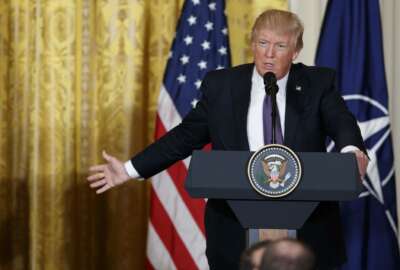

President Donald Trump signed an executive order establishing the American Technology Council to transform and modernize the federal government’s information...
First, President Donald Trump created the Office of American Innovation to bring in private sector expertise to help the government tackle tough technology problems. Now, the President is complimenting OAI with the American Technology Council (ATC).
Trump signed an executive order establishing the council to “transform and modernize [the federal government’s] information technology and how it uses and delivers digital services.”
White House Press Secretary Sean Spicer said during the May 1 briefing that the President signed the order over the weekend, and it will be led by Chris Liddell, director of Strategic Initiatives at the White House.
Liddell also is playing a key role along with Reed Cordish, the assistant to the President for intragovernmental and technology initiatives, on OAI. Cordish also will have a seat on the new technology council.
The ATC will focus on three main areas:
Along with the White House executives such as Liddell, Cordish, the President and Vice President, ATC includes the federal chief information officer, the federal chief technology officer, the director of the Office of Management and Budget, the commissioner of the Technology Transformation Service at the General Services Administration, the administrator of the U.S. Digital Service and the secretaries of Defense, Homeland Security and Commerce and the Director of National Intelligence. Trump has yet to name a new federal CIO or CTO.
“The director may invite the heads of agencies with key service delivery programs to attend meetings of the ATC on a rotating basis and may also invite the heads of those service delivery programs to attend,” the order stated. “The President, or upon his direction, the director, may also invite other officials of executive departments, agencies, and offices to attend meetings of the ATC from time to time.”
The order doesn’t clearly state the difference between ATC and OAI.
When Trump announced the creation of the innovation office back in March, Spicer said early priorities for the office will be modernizing technology in the federal government and overhauling the Department of Veterans Affairs.
“This office will bring together the best ideas from government, the private sector, and other thought leaders to ensure that America is ready to solve today’s most intractable problems, and is positioned to meet tomorrow’s challenges and opportunities,” President Trump wrote in the memo released March 27. “The office will focus on implementing policies and scaling proven private-sector models to spur job creation and innovation.”
Among the areas OAI will look at is acquisition of IT.
OAI and ATC are similar to an idea tried during the administration of President Barack Obama, called the President’s Management Advisory Board.
Like these new efforts, PMAB brought in a rotating set of industry experts to advise agencies on what private sector best practices could be used in government. Agencies had mixed results in putting suggestions from PMAB members into practice as the differences between industry and government played a larger role.
Copyright © 2025 Federal News Network. All rights reserved. This website is not intended for users located within the European Economic Area.
Jason Miller is executive editor of Federal News Network and directs news coverage on the people, policy and programs of the federal government.
Follow @jmillerWFED

